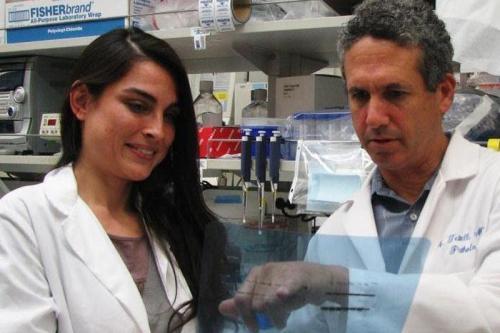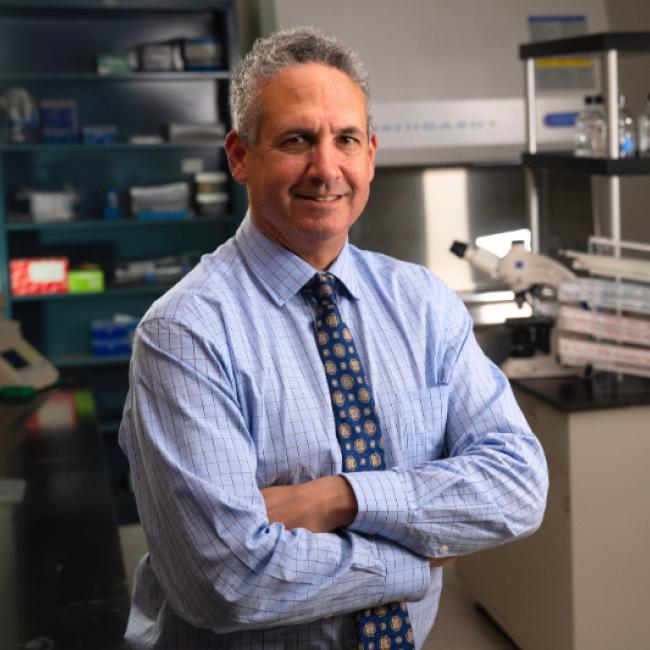
Building bridges for future stem cell researchers
Sarah Imam had her sights set on medical school until a unique program offered at Cal State University Northridge (CSUN) in partnership with the UCLA stem cell center steered her in a new direction.
Imam now envisions a future in science and medicine - with both a doctorate and medical degree - after spending time as a researcher in a laboratory at the Eli and Edythe Broad Center of Regenerative Medicine and Stem Cell Research at UCLA through the CSUN-UCLA Bridges to Stem Cell Research program.
The program is funded through the California Institute of Regenerative Medicine (CIRM), the state’s stem cell agency, and seeks to train the next generation of stem cell scientists and laboratory technicians by funding courses and research internships for undergraduates and masters-level students.
UCLA partnered with CSUN two years ago, and each year for six years a total of 10 students will be given the eye-opening, mind-expanding opportunity to work in stem cell research labs and be trained by renowned stem cell scientists.
“It's been amazing,” Imam, 29, of North Hollywood, said of the program. “I pinch myself every day that I get to go to UCLA and work in a lab. It’s a total immersion experience, which makes everything much easier to absorb.”
The Bridges students work full-time in the labs and receive a monthly stipend of $2,500. The lab hosting the student receives $3,000 from CIRM, an amount matched by the UCLA Broad stem cell center, to pay for necessary research materials such as reagents, enzymes and other laboratory supplies. Bridges students also receive $2,000 to support their attendance at important stem cell conferences.
The stipend allows students to focus all of their attention on stem cell research. Participants are not allowed to hold other jobs, said Dr. Michael Teitell, a professor of pathology and laboratory medicine and pediatrics and a practicing physician and scientist who mentors Bridges students and helps to coordinate the UCLA arm of the program.
“The goal is to train undergrads and master’s level students in stem cell biology,” said Teitell, who currently is mentoring Imam. “This provides an opportunity for students attending CSUN to work in top UCLA labs and get world class exposure to stem cell science.”
Cindy Malone, an associate professor of biology, directs the program for CSUN. She characterizes Bridges as an “opportunity of a lifetime.”
“The Bridges students are exposed to projects and experiences that we can’t provide to them here under any circumstances,” said Malone, who teaches and runs a lab at CSUN. “We don’t have the kind of research facilities or the resources that UCLA has. This program offers students the whole environment of being immersed in a research career.”
Students spend nine months to a year working in the UCLA stem cell labs. Once at UCLA, the students are paired with either a graduate or post-doctoral student who, with the guidance of the faculty mentor, helps them create and develop their own research project.
“It’s an intense commitment and most of the students end up working a lot more than they thought they would,” Malone said. “The projects take on lives of their own and become all consuming.”
That has proven true for Imam, who is studying the unique metabolic properties of stem cells, which are different than those of mature cells. She has found that stem cell metabolism is very similar to cancer cell metabolism and the conclusions she ultimately draws from her research may have implications for cancer research. She hopes to uncover an Achilles heel in cell metabolism that might one day prove to be a target for therapy.
“My experience in the Bridges program has changed my perspective,” she said. “I see research now as an indispensable element to medicine, and it’s exciting to think of a future contributing to solutions to challenging medical conditions.”
Imam has immersed herself in the program, attending weekly seminars that feature renowned scientists from other stem cell centers nationwide. She also has gone to extra-mural symposia, where she has presented posters detailing her research project. In June, she’ll be traveling to Japan for the International Society of Stem Cell Research meeting, which draws top scientists from all over the world. She has submitted an abstract of her research and hopes it is accepted.
Generally, Imam works seven days a week in Teitell’s lab and her hours are flexible, planned around the experiments she needs to conduct for her research. Working long days is not unusual, she said.
“My experience has been consuming and an absolute pleasure,” Imam said. “I can’t believe a program like this really exists.”
Roonalika Wisidagama, 28, of Northridge, was among the first group of Bridges students to experience working in a UCLA stem cell laboratory. She worked as an undergraduate in Malone’s lab at CSUN and served as the lab manager. She recently was accepted in the doctoral program at the University of Utah and is currently completing her master’s thesis.
Like Imam, Wisidagama found the Bridges program to be illuminating.
“It was definitely a very positive experience, very intense and I enjoyed every bit of it,” said Wisidagama, who has always wanted to be a scientist. “The Bridges program encouraged me, supported my goal to become a scientist and made me want to pursue master’s and doctorate degrees.”
She had been thinking about applying for positions in the biotech industry, but now may set her sights on a career at an academic medical center like UCLA because she found the experience so enriching.
While in the Bridges program, Wisidagama also attended weekly UCLA seminars and international conferences. She presented her work in both posters and presentations, an experience that was challenging but also very enjoyable.
Wisidagama also worked in Teitell’s lab, and she found her mentor to be very approachable and available.
“He’s incredibly busy, but his door is always open to you,” she said. “He knows how to talk science on multiple levels. I was an undergraduate when I went into his lab and he knew not to overwhelm me at first. He was very good at giving me personal attention.”
Bridges officials currently are screening applicants to select the third round of students, who will start the program in the fall, and CIRM has provided funding for three additional years. In all, CIRM has given out 16 Bridges to Stem Cell Research Awards to state universities and community colleges across California.
Not only has the program exposed CSUN students to world class stem cell science, it also has expanded UCLA’s work force. Several program graduates are currently working in UCLA stem cell labs, Teitell said. Others have gone on to graduate school, medical school or applied for jobs in the biotech industry.
In addition to Teitell, UCLA stem cell scientists currently participating in the program include Dr. Owen Witte, the stem cell center director, Bennett Novitch, William Lowry, Dr. Hanna Mikkola, April Pyle, Jerry Zack, Dr. Brigitte Gomperts, Karen Lyons and Dong Song An.
